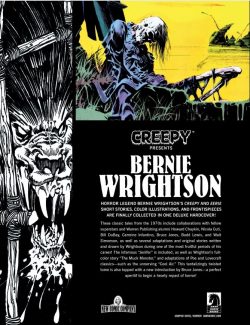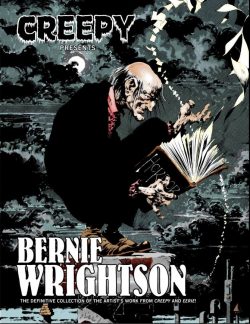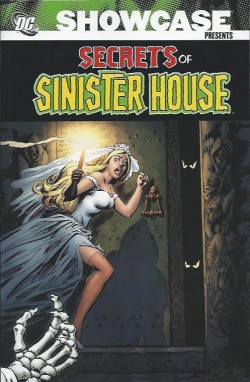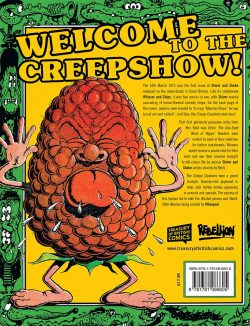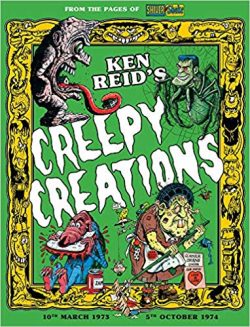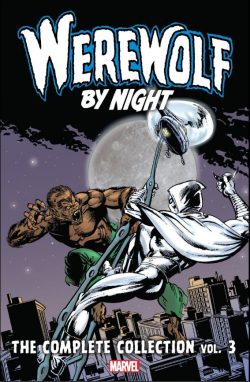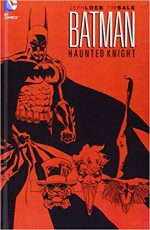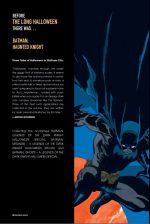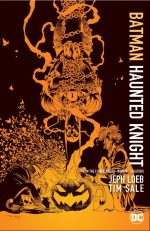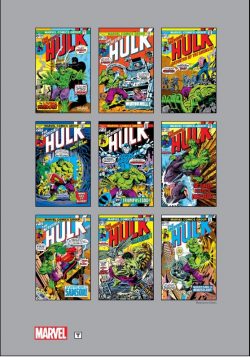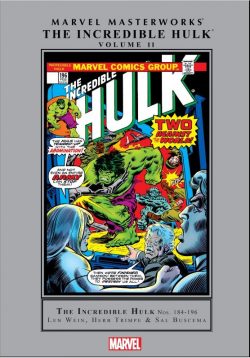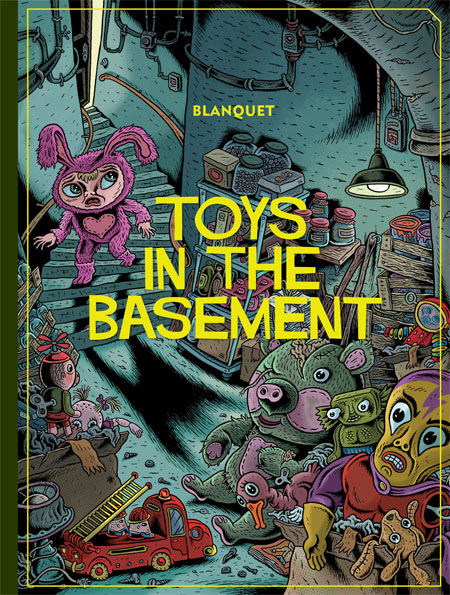

By Steve Ditko & various, edited by Blake Bell (Fantagraphics Books)
ISBN: 978-1-60699-498-6 (HB)
Win’s Christmas Gift Recommendation: Immaculate Seasonal Yarn-Spinning… 10/10
Once upon a time the anthological title of short stand-alone stories was a top product of the comicbook profession, delivering as much variety as possible to the reader. At the peak of that period, nobody could touch Steve Ditko for variety of touch and tone, not to say sheer volume…
Ditko was one of our industry’s greatest talents and one of America’s least lauded. His fervent desire to just get on with his job and to tell stories the best way he could – whilst the noblest of aspirations – was, at best, a minor consideration and more usually a stumbling block for the commercial interests which controlled all comics production and still exert an overwhelming influence upon the mainstream bulk of comicbook output today.
Before his time at Marvel, young Ditko perfected his craft, creating short, sharp visually attractive vignettes for a variety of companies, and it’s an undeniable joy today to be able to look at this work from such an innocent time when he was just breaking into the industry: tirelessly honing his craft with genre tales for whichever publisher would have him, utterly free from the interference of intrusive editors.
This superb full-colour series of archival hardback collections (also available as digital editions) reprints those early efforts for Charlton Comics published between June 1957 through July 1958 – with material produced after the draconian, self-inflicted Comics Code Authority sanitised the industry following Senate Hearings and a public witch-hunt.
Here are wonderfully baroque and bizarre supernatural or science fiction and fantasy stories – presented in the order he completed and delivered them rather than the more logical, but far-less-revealing, chronological release dates. Moreover, they are all helpfully annotated with a purchase number to indicate approximately when they were actually drawn. Sadly, there’s no indication of how many (if any) were actually written by the moody master, so it’s safest to assume co-creator credits go to the utterly professional Joe Gill…
This third tension-packed presentation reprints another heaping helping of Ditko’s ever-more impressive works: most of it courtesy of the surprisingly liberal (at least in its trust of its employees’ creative instincts) sweat-shop publisher Charlton Comics.
And whilst we’re being technically accurate, it’s also important to reiterate that the cited publication dates of these stories have very little to do with when Ditko crafted them: as Charlton paid so little, the cheap, anthologically astute outfit had no problem in buying material it could leave on a shelf for months (sometime years) until the right moment arrived to print. The work is assembled and runs here in the order Ditko submitted it, rather than when it reached the grubby sweaty paws of us readers. It also coincides with a brief period when the company began releasing double-sized giant issues…
Following another historically informative Introduction with passionate advocacy by Editor Blake Bell, concentrating on Ditko’s military service experience and admiration and relationship with artist, educator and major influence Jerry Robinson, the evocatively eccentric excursions open with ‘From All Our Darkrooms…’ as first seen in Out of This World #4 (cover-dated June 1957) wherein photographers worldwide begin seeing otherwise-invisible aliens in the prints…
When a brash and ecologically unsound new owner threatens an ancient stand of trees he falls foul of ‘The Menace of the Maple Leaves’ (Strange Suspense Stories #33, August).
Ditko was astoundingly prolific – as was writer Gill – and increasingly Charlton’s various mystery and sci fi mags offered more than one effort per issue. As well as the cover to Unusual Tales #8 (also August), the tireless creator crafted ‘Will Power’, a classical tale of the power of love and statues coming to life and ‘The Decision’ wherein a wise precaution saves humanity from a robotic rampage after which Mysteries of Unexplored Worlds #4 (July) sees a devious long con wrecked by paranormal intervention in ‘The Forbidden Room’…
A dictatorial brute earns a grim comeuppance in ‘The Strange Fate of Captain Fenton’ in Mysteries of Unexplored Worlds #6 (December), before the cover of This Magazine is Haunted volume 2 #12 (July) ushers in a titanic tale of mythological woe and the end of ‘The Last One’, whilst, for one misguided soul in Strange Suspense Stories #35 (December), ‘Free’ is just another cruel word.
The belligerent threat of a ‘Stranger in the House’ (Mysteries of Unexplored Worlds #5, October) is tackled through divine intervention, but far more mundane answers are forthcoming for the devilish spy on the run in ‘All Those Eyes’ in Out of This World #6 (November).
A quartet of later-rendered tales from This Magazine is Haunted v2 #12 come next: beginning with alien inimical invaders dubbed ‘The Faceless Ones’ who pick the wrong human to replace, whereas random, kind fate saves humanity from ‘The Thing on the Beach’. A tragic, lonely ventriloquist is unable to escape ‘His Fate’, and the showbiz theme expands to involve a crooked impresario holding shrunken people captive in ‘The Messages’…
Behind the cover of This Magazine is Haunted volume 2 #13 (October) a lonely scientist and man’s best friend thwart ‘The Menace of the Invisibles’, before Strange Suspense Stories #34 (November, and with cover included) discloses an ironic fate for a manic Nazi hidden in the sands who can’t escape ‘The Desert Spell’…
The cover – and its original art – for Out of This World #5 (September) are accompanied by ‘The Night They Learned the Truth’ – a twisted tale of nervous villagers extending a traditional unwelcome to a strange foreigner after which the cover to Unusual Tales #9 (November) segues into a tale of corrupt businessman getting what he deserves in ‘He’s Coming for Me!’…
Two more from Out of This World #5 begin with bizarrely multi-layered tale of retribution ‘I Made a Volcano’, and wrap up with maritime monster mash ‘The Thing from Below’, after which ‘Father Help Me!’ (Mysteries of Unexplored Worlds #6, December) adds a technological twist to the ancient dilemma of a good parent afflicted with an evil child…
A last contribution to Mysteries of Unexplored Worlds #5, ‘Live for Reunion’ confronts a troubled child with a ghostly dilemma, before ‘Clairvoyance’ (Unusual Tales #9, November 1957) tackles the thorny problem of a super-child who only wants to be ordinary…
Guilt drives an unscrupulous businessman to see ‘The Scar’ everywhere in another mood message from Strange Suspense Stories #34, before more Mysteries of Unexplored Worlds #6 resume with the hunt for a progress-wrecking guru in ‘Where is Kubar?’ and conclude with the unhappy revelations of a hypnotist who sees too much after saying ‘Look Deep into My Eyes’…
Next up is a tale from one of Charlton’s earliest leading characters and the eponymous star of this volume. The title was developed from a radio show that Charlton licensed the rights to, with the host/narrator acting more as voyeur than active participant. “The Mysterious Traveler†broke the fourth wall and spoke directly to us, asking readers for opinion and judgement as he shared a selection of funny, sad, scary and wondrous human-interest yarns, all tinged with a hint of the weird or supernatural.
When rendered by Ditko, whose storytelling mastery, page design and full, lavish brushwork were just beginning to come into its mature full range, the works of Tales of the Mysterious Traveler were always exotic, esoteric and utterly mesmerising…
From issue #6 – and following a deftly compartmentalised cover dated December 1957 – comes ‘Tomorrow’s Punishment’, as a gang of crooks use a fortune-telling mirror to carry out their capers, after which a close encounter for a beggar makes him ‘The Man Who Saw Again’ (Tales of the Mysterious Traveler#8 from July 1958).
‘The Man Who Lost His Face’ is a tight alien invasion fable from Strange Suspense Stories #34 that leads seamlessly into a case of medical time travel salvation on a most fortuitous ‘Night Call’ (Mysteries of Unexplored Worlds #6) before Cold War counter espionage makes an accidental hero of ‘The Atomic Clerk’ in Strange Suspense Stories #34.
Another cover and its original art (Out of This World #6, November) leads into a potent tale of unnatural nature in ‘The River’s Wrath’, after which Unusual Tales #9 shares a tale of perceived ‘Escape’ for an unrepentant fugitive, whilst ‘The Night of Red Snow’ shows an insular town the power of unfettered art and imagination…
‘Plague’ also comes from Out of This World #6, revealing how a bitter scientist almost destroys the world, before the cover to Tales of the Mysterious Traveler #5 (November 1958) precedes a triptych of thrillers beginning with ‘The Sultan’ whose thirst for oil leads to inescapable doom, carries on with the shocking vision an arrogant climber sees ‘Above the Topmost Peak’, and ends with a deadly case of mistaken identity for deep seas divers in ‘The Man Below’…
From Strange Suspense Stories #34 (March 1958) comes a painful homily of trust despoiled when an elderly salesman honestly earns a miracle, only to realise he can’t rely upon his nearest and dearest, before this timeless celebration concludes with a selection from This Magazine is Haunted volume 2 #13 (October, 1957).
A craven white hunter steals an idol but cannot escape ‘The Drums’, even as a bum becomes ‘The Man Who Changed Bodies’, but can’t avoid the pitfalls of his own nature before a driven victim futilely hunts for a hated transgressor in ‘He Shall Have Vengeance’…
This sturdily capacious volume has episodes that terrify, amaze, amuse and enthral: utter delights of fantasy fiction with lean, plots and stripped-down dialogue that let the art set the tone, push the emotions and tell the tale, from times when a story could end sadly and badly as well as happily and only wonderment was on the agenda, hidden or otherwise.
These stories also display sharp wit and honest human aspiration and integrity, making ithis another superb collection in its own right as well as a telling tribute to the genius of one of the art-form’s greatest stylists.
This is something every serious comics fan would happily kill or die or be lost in time for…
Mysterious Traveler: The Steve Ditko Archives Vol. 3. This edition © 2012 Fantagraphics. Introduction © 2012 Blake Bell. All rights reserved.

